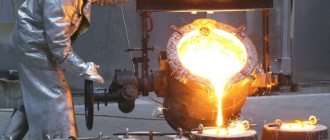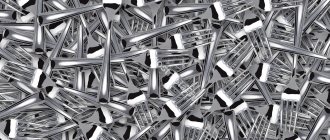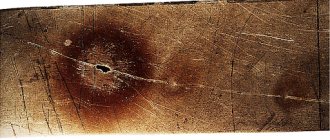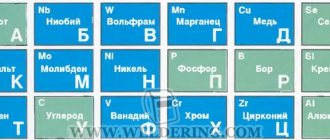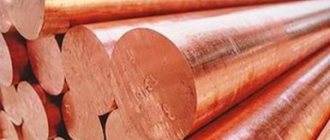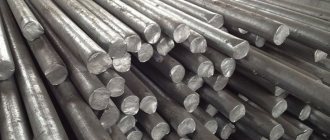Stainless steel marking: subtleties of marking stainless steel
Marking, which is used to designate various types of stainless steels, allows you to obtain information not only about the chemical composition of the alloy, but also about the basic properties that it possesses. The rules for the formation of a designation consisting of alphabetic and digital characters are regulated by the provisions of both domestic and international regulatory documents.
Thin-walled stainless steel pipe 12Х18Н10Т
Rules for marking steel alloys in different countries of the world
Steel of various grades, which is widely represented on the modern market, is produced in many countries around the world. In this regard, the issue of adopting international rules by which it is designated is relevant. However, unfortunately, there are no uniform rules for the designation of steels to this day, which often causes serious difficulties both in the sale of such alloys on the international market and in their use in industry.
Some countries (we are talking primarily about the largest steel producers) have adopted their own regulatory documents according to which marking is carried out. For a consumer from another region to choose the right steel, it is necessary to compare its markings with the designations adopted in his country.
European steel marking scheme
In European countries, steel is produced and designated according to the provisions of the EN 100 27 standard, which consists of two parts. The first of these parts stipulates the principle by which steel alloys are assigned certain names, and the second - the principle of assigning numerical designations to steel.
An example of decoding a European steel grade
In Russia, as in many CIS countries, the principle of steel marking is used, borrowed from the old Soviet GOSTs. In accordance with this principle, steel markings are formed from alphabetic and numeric symbols. The numbers indicate the content of certain chemical elements in the alloy, and the letters are the coded names of these elements, as well as the methods by which steel was smelted.
In the USA, which is the largest steel producer, several steel designation systems are used - SAE, AJS, AMS, ASTM, ANSI, ASME, AWS and ACJ. The most common of them, due to greater unification, is ANSI.
Designation of steels in the AISI system
A fairly complex stainless steel marking system is used in Japan. So, in accordance with this system, all steel alloys are divided into separate groups, each of which is designated by a specific letter. Within each of these groups, steels are divided into subgroups, marked with numbers, from which one can determine the chemical composition of the alloy, as well as obtain information about its properties.
Naturally, all of the above systems are used for marking both ordinary and stainless steels.
Compliance of stainless steels with various standards
Principles of designation of stainless steels in Russia and CIS countries
Stainless steels in Russia and the CIS countries, as mentioned above, are marked using a combination of alphabetic and digital symbols. In this case, the former indicate what chemical elements are contained in the steel, as well as the methods of its smelting, and from the numbers one can determine the quantitative content of the elements listed in the designation of stainless steel.
All letter designations of chemical elements used in marking stainless steels are unified and can be used to unambiguously determine the composition of stainless steel.
Thus, the standard, the basis of which was the Soviet GOST, stipulates the following letter designations of chemical elements:
- C – silicon, which is introduced into the composition of stainless steel so that a layer of scale does not form on the surface of products made from it after heat treatment;
- Yu - aluminum, with the help of which they achieve stabilization of the structure of stainless steel, and also reduce the risk of the formation of foreign inclusions in the structure of the alloy, which can occur at the moment when products made from it come into contact with boiling liquids;
- X – chromium, which is the main alloying element of all stainless steel alloys and gives them exceptional corrosion resistance, for which they are valued;
- M – molybdenum, which imparts stability to the structure of stainless steels during their interaction with aggressive gas environments;
- E – selenium, which provides stainless steel products with the required electrical resistance parameters;
- P – boron, which increases the corrosion resistance of steels when exposed to chemical environments and high temperatures;
- K – cobalt, used to stabilize the carbon contained in steel;
- P – phosphorus, used in steel as a corrosion passivator;
- B – niobium, which is introduced into the composition of stainless steel in order to activate ferritic processes occurring in the crystals of the internal structure of the metal;
- F – vanadium, added to stainless steel to increase its ductility.
Additional letters in the marking of high-quality steels
Naturally, this is not the entire list of chemical elements that may be contained in stainless steel. Like any other steel, a stainless alloy necessarily contains carbon (the letter “U” in the marking), which not only gives it the required strength characteristics, but also increases its resistance to oxidative processes. To give stainless steel good malleability and increase its resistance to high temperatures, nickel is added to it, which is designated by the letter “N” in the alloy markings.
Despite the fact that stainless steels are already highly corrosion resistant, the degree of such protection can be increased by adding copper to their composition, designated in the marking by the letter “D”. In addition to the listed elements, stainless steels may contain manganese (letter “G”), titanium (“T”), zirconium (“C”) and tungsten (“B”).
Chemical composition and designation of stainless steel grades
| Gr. become | steel grade | Content of alloying elements, % | ||||||||||||
| EN Europe | AISI USA | GOST CIS | DIN Germany | Cr | Ni | Mo | Cmax | Simax | Mn max | Pmax | S max | Al | Ti | |
| A1 | 1.4305 | 303 | — | X8CrNiS 18-9 | 16 – 19 | 5 – 10 | 0,7 | 0,12 | 1,0 | 6,5 | 0,20 | 0,15 – 0,35 | ||
| A2 | 1.4301 1.4303 | 304 305 | 08Х18Н10 12Х18Н12 | X5CrNi 18-10 X4CrNi 18-12 | 15 – 20 | 8 – 19 | * | 0,10 | 1,0 | 2,0 | 0,05 | 0,03 | ||
| A3 | 1.4541 | 321 | 08Х18Н10Т | X6CrNiTi 18-10 | 17 – 19 | 9 – 12 | * | 0,08 | 0,045 | 5xC – 0.70** | ||||
| A4 | 1.4401 | 316 | 10Х17Н13М2 | X5CrNiMo 17-12-2 | 16 – 18,5 | 10 – 15 | 2,0 – 3,0 | 0,08 | 1,0 | 2,0 | 0,045 | 0,03 | ||
| A5 | 1.4571 | 316Ti | 10Х17Н13М2Т | X6CrNiMoTi 17-12-2 | 10,5 – 14 | 5xC – 0.70** | ||||||||
| A- | 1.4439 | S31726 | X2CrNiMoN 17-13-5 | 16,5 – 18,5 | 12,5 – 14,5 | 4,0- 5,0 | 0,03 | 1,0 | 2,0 | 0,045 | 0,015 | |||
| A- | 1.4539 | N08904 | X1NiCrMoCu 25-20-5 | 19 – 21 | 24 – 26 | 0,02 | 0,7 | 0,03 | 0,01 | |||||
| A- | 1.4529 | X1NiCrMoCu 25-20-7 | 6,0 – 7,0 | 0,5 | 1,0 | |||||||||
| A/F- | 1.4462 | X2CrNiMoN 22-5-3 | 21 – 23 | 4,5 – 6,5 | 2,5 – 3,5 | 0,03 | 1,0 | 2,0 | 0,035 | 0,015 | ||||
| C- | 1.4034 | 420 | 40Х13 | X46Cr13 | 12,5 – 14,5 | 0,43 – 0,50 | 1,0 | 1,0 | 0,04 | 0,03 | ||||
| C- | 1.4122 | X39CrMo 17-1 | 15,5 – 17,5 | ≤1,0 | 0,8 – 1,3 | 0,33 – 0,45 | 1,0 | 1,5 | 0,04 | 0,03 | ||||
| A- | 1.4310 | 301 | X10CrNi 18-8 | 16 – 18 | 6 – 9,5 | ≤0,8 | 0,05 – 0,15 | 2,0 | 2,0 | 0,045 | 0,015 | |||
| C- | 1.4568 | 301 | X7GNiAl 17-7 | 16 – 18 | 6,5 – 7,8 | 0,09 | 0,7 | 1,0 | 0,04 | 0,015 | 0,7 – 1,5 | |||
* Molybdenum is allowed at the discretion of the manufacturer
** For stabilization, titanium must be contained in a volume of ≤5xC up to a maximum of 0.7%
Designations of chemical elements in tables:
- Cr - Chromium;
- Ni - Nickel;
- Mo—Molybdenum;
- C - Carbon;
- Si - Silicon;
- Mn—Manganese;
- P - Phosphorus;
- S - Sulfur;
- Al - Aluminum;
- Ti - Titanium.
Symbol system:
In the Russian designation of steel grades:
Steel 12Х18Н10Т: 12 – 0.12% C (carbon); X18 - 18% Cr (chromium); H10 - 10% Ni (nickel); T - up to 1.5% Ti (titanium).
- Stainless steel according to GOST
- the first 2 digits indicate the average mass fraction of carbon in hundredths of a percent;
- letters indicate the name of the chemical elements (X - chromium; H - nickel; M - molybdenum; T - titanium);
- The numbers behind the letters indicate the approximate mass fraction of the alloying element in whole units. The absence of a number means that the brand contains up to 1.5% of this alloying element, unless otherwise stated.
Stainless steel according to EN/DIN
The designation system differs from the Russian one in the order of reflection of the chemical element in steel and its share; if in the Russian designation system information about the share of the element in the alloy is indicated immediately after the element, then in the designation of stainless steel according to DIN/EN all chemical elements are indicated first, and then The shares of elements are indicated in the same order.
The first digit indicates the average mass fraction of carbon in hundredths of a percent.
Steel X5CrNi 18–10: 5 - 0.05% C (carbon); Cr - 18% chromium; N - 10% nickel.
Source: smetiz.ru
What do the numbers on the label indicate?
The numbers present in the markings allow you to find out the number of elements contained in stainless steel. When understanding the marking of such an alloy, it should be borne in mind that the very first numbers before the letter designation indicate the carbon content in tenths of a percent. For example, stainless steel grade 12Х18Н10Т contains 0.12% carbon.
Marking of structural steel grades
Behind each letter in the alloy marking, as can be seen from the example given, there is also a number that indicates the content of a certain chemical element, but in whole percentages. Thus, the alloy considered as an example, in accordance with its marking, contains the following chemical elements:
- chromium – 18%;
- nickel – 10%;
- titanium - up to 1.5% (since there are no numbers after the letter designation of this element).
Steel marking - the meaning of digital and letter indices
Knowing the designation of letter indices and the semantic meaning of the numbers used in steel marking, one can draw conclusions about the need for the proposed grade for a specific purpose, without even looking in the reference book. Overpay for the titanium contained in the alloy if you do not need the high fire-resistant properties acquired by alloying with this expensive metal.
Some letter indices can change the designating element, depending on its location in the marking. Consider the correspondence of letter indices:
- A (at the beginning of the marking) – S
- A (in the middle of the marking) – N
- B – Nb
- B – W
- G – Mn
- D – Cu
- E–Se
- K – Co
- M – Mo
- N – Ni
- P–P
- P–B
- C – Si
- T – Ti
- F – V
- X – Cr
- C – Zr
- Yu – Al
- h – REM
The amount of each of them in the alloy is determined by the numerical value following the letter indicating the element. Expressed as a percentage. In cases where an individual element is small, less than 1%, the number is not placed after the letter index. Carbon, as an important element, is located in front of the marking, but is expressed in hundredths of a percent.
FeNi and Ni alloys are marked only with letter indices. The exception is the number after nickel (mass fraction) and carbon (FeNi only).
If the steel was produced using special smelting methods or remelting methods, this is indicated with a hyphen after the marking. Such special methods and methods include various methods of vacuum remelting, electron beam melting, treatment with slags of synthetic origin, and others. The total number of specific methods for obtaining the required grade of alloy is specified in the standard: 24.
Let's look at examples of deciphering the markings of stainless steels 05Х12Н2М and 04Х14Т3Р1Ф-ВД. 05Х12Н2М contains 0.05% carbon, 12% chromium, 2% nickel, and up to 1% molybdenum content. 04Х14Т3Р1Ф-ВД stands for: carbon 0.04, 14% chromium, 3% titanium, 1% boron, vanadium less than 1% percent, obtained by vacuum arc remelting.
Classification
In the metallurgical industry, more than two hundred types of alloy alloys are distinguished. They differ in the presence of different amounts of additional chemical elements in their composition.
There are four main types of stainless steel.
- Ferritic. These are low-carbon alloys containing more than 20% chromium and less than 0.15% carbon. They have a bulk crystalline structure. Durable, plastic. This type of steel has magnetic properties.
- Austenitic. Corrosion-resistant alloys containing 18% chromium and 8 to 9% nickel. They retain ductility in cold and hot states, are easy to weld, and have high strength. There are unstabilized and stabilized brands. The latter varieties are characterized by the presence of titanium and niobium.
- Martensitic. Steels of this type contain 17% chromium, 0.05% carbon. Metals are ductile, elastic, and do not react with aggressive environments. They are not exposed to high temperatures and are considered a wear-resistant material.
- Combined. There are austenitic-ferritic and austenitic-martensitic steels. The development and production of such alloys is carried out according to customer requirements.
Purpose of the most commonly consumed stainless steels
steel grade
For parts with increased ductility and subject to shock loads; parts operating in mildly aggressive environments
For parts with increased hardness; cutting, measuring, surgical instruments, compressor valve plates, etc.
For various parts of the chemical and aviation industries Has high technological properties
For high hardness parts operating under wear conditions
Recommended as a substitute for steel 12Х18Н10Т for structures not exposed to shock at operating temperatures not lower than -20° C
Similar to steel 08Х17Т, but for parts operating in more aggressive environments at temperatures from -20 to 400 ° C (15Х28 for joints with glass)
Substitute for steels 12Х18Н9, 17Х18Н9 for welded structures
For high-strength products, elastic elements; steel 09Х15Н8У – for acetic and saline environments
Main grades of steel and their use in industry
Different grades of stainless steel and their characteristics are designed to work in different environments and conditions, let's consider the most popular and in demand:
- 12Х13, 08Х13, 20х13 for the manufacture of dishes and cutlery, elements and structures with shock loads. Resistant to aggressive environments at normal temperatures. With heat treatment and (or) polishing, the anti-corrosion properties and characteristics are improved.
- 12Х17, 08Х18Т1 is a marking of food grade stainless steel for household kitchen utensils, as well as for equipment for food industry enterprises. It is rational to use products after annealing.
- 30Х13, 40Х13 grade of medical stainless steel from which surgical instruments are made
- 40Х9С2 grade of heat-resistant stainless steel intended for the manufacture of valves for exhaust manifolds of internal combustion engines, diesel engines, heat exchangers.
- 15Х25Т stainless heat-resistant steel is used in high-temperature pyrolysis equipment.
- 12Х18Н9Т for the manufacture of pipes and furnace fittings, spark plug housings
- 40Х9С2 heat-resistant stainless steel, grade intended for engine valves
- 14Х17Н2 equipment operating in environments up to 800 degrees Celsius
- 10Х23Н18 products operating under reduced load conditions and temperatures below 1000 degrees Celsius
Stainless steel markings
In Russia, alloying alloys are produced in accordance with GOST 5632-2014. Marking is a combination of numbers and letters. The number at the beginning indicates the carbon content of the alloy. The numbers located after the letters indicate the average mass fraction of the alloying element, which is indicated in the form of letters of the Russian alphabet.
The composition of foreign brands is standardized by the standards existing in the country of origin. AISI, named after the American research institute “The American Iron and Steel Institute,” has become popular in the Russian Federation. The first digit indicates the type of alloy, the next two indicate the serial number in the entire group of this class. The reduced amount of carbon in the AISI system is indicated by an additional letter L.
Correspondence table of popular foreign brands with Russian analogues
| steel grade | GOST 5632-2014 | AISI |
| Ferritic | 08Х13; 12X13; 12Х17 | 409; 410; 430 |
| Austenitic | 12Х18Н10Т; 08Х18Н10; 08Х17Н13М2 | 321; 304; 316 |
| Martensitic | 20Х13; 30Х13; 40 X13 | 420 |
Interpretation of stainless steel markings according to GOST
The numbers and letters in the designation according to GOST determine the chemical elements in the alloy and their quantity as a percentage. For example, stainless steel grade 12x18n10t . The number at the beginning indicates the quantitative carbon content in hundredths of a percent. If the first digit is missing in the brand, this means that the carbon in the alloy is more than 1%. The letter indicates the alloying element, and the subsequent number indicates its quantitative percentage. So, x18 means that this alloy contains 18% chromium. Letters without a subsequent number mean that the amount of this element is less than 1.5%. In this alloy it is T - titanium.
Stainless, structural and special steels.
Marking systems for steels and alloys.
The presence of a wide range of steels and alloys produced in different countries has necessitated their identification, but to date there is no unified system for marking steels and alloys, which creates certain difficulties for the metal trade.
Thus, in Russia and the CIS countries (Ukraine, Kazakhstan, Belarus, etc.), an alphanumeric system for designating steel and alloy grades, developed early in the USSR, has been adopted, where, according to GOST, letters conventionally indicate the names of elements and methods of steel smelting, and numbers indicate the content elements.
The European steel designation system is regulated by standard EN 100 27. The first part of this standard determines the order of naming steels, and the second part regulates the assignment of serial numbers to steels.
In Japan, the names of steel grades usually consist of several letters and numbers. The letter designation determines the group to which the steel belongs, and the numbers indicate its serial number in the group and its property.
In the United States, there are several systems for naming metals and their alloys. This is due to the presence of several standardization organizations, these include AMS, ASME, ASTM, AWS, SAE, ACJ, ANSI, AJS. It is quite clear that such marking requires additional clarification and knowledge when trading metal, placing orders, etc.
To date, international standardization organizations have not developed a unified steel marking system. In this regard, there are discrepancies that lead to errors in orders and, as a result, poor quality of products.
In Russia and the CIS countries, an alphanumeric system has been adopted, according to which numbers indicate the content of steel elements, and letters indicate the name of the elements. Letter designations are also used to indicate the method of deoxidation of steel: “KP - boiling steel, PS - semi-quiet steel, SP - calm steel”. There are certain features of the designation for different groups of steels: structural, construction, tool, stainless steel, etc. Common designations for all are the letter designations of alloying elements: H - nickel, X - chromium, K - cobalt, M - molybdenum, B - tungsten, T - titanium, D - copper, G - manganese, C - silicon. Structural steels of ordinary quality, unalloyed (GOST 380-94) are designated by the letters ST., for example ST. 3. The number after the letters conventionally indicates the percentage of carbon in the steel.
Structural unalloyed quality steels (GOST 1050-88) are designated by a two-digit number indicating the average carbon content in the steel (for example, ST. 10).
High-quality steels for the production of boilers and high-pressure vessels according to (GOST 5520-79) are designated as structural non-alloy steels, but with the addition of the letter K (for example, 20K).
Structural alloy steels, according to GOST 4543-71, are designated by letters and numbers. The numbers after each letter indicate the approximate content of the corresponding element, however, if the content of the alloying element is less than 1.5%, the number after the corresponding letter is not placed. Additional qualitative indicators, the reduced content of impurities such as sulfur and phosphate, are designated by the letter - A or Ш, at the end of the designation, for example (12 Х НЗА, 18ХГ-Ш), etc. Cast structural steels, according to GOST 977-88, are designated as high-quality and doped, but at the end of the name they put the letter L.
Decoding of marking according to the European system
The EN system uses only numbers with a dot separator. The first digit determines the material group, where 0 is cast iron, 1 is steel, 2 is heat-resistant alloys, 3 is non-ferrous metals and alloys. The two digits after the dot indicate the steel group, and the subsequent numbers indicate the steel number in the group.
The Metallobaza No. 2 company has a wide range of stainless steel products, which allows you to buy stainless steel that meets international quality standards.
Source: nerzhaveyka-spb.ru
Advantages of stainless steels
With the development of economic, scientific and technological progress, the requirements for the quality of materials used in areas of the national economy are growing.
Advantages of alloy metals:
- High level of anti-corrosion properties.
- Compliance with the standards stipulated by fire safety regulations.
- Reliability, long service life without changing technical characteristics.
- Ideal combination with any building materials.
- Variety of surfaces: polished, polished, matte, decorative.
- Wide selection of rolled metal products.
- Ease of processing, molding, and assembly of parts made from this type of steel.
- A wide range of brands with unique properties.
- Environmental safety, hygiene.
Application
The listed advantages contribute to maintaining a leading position in the rolled metal market. Anti-corrosion alloys are an indispensable material in heavy engineering, energy, oil and gas and agricultural sectors.
The material is in demand in the following areas of the national economy:
- Construction, architecture;
- production of equipment and medical instruments;
- pulp and paper production;
- food industry;
- transport engineering;
- chemical industry;
- electrical power and electronics;
- production of household appliances and household items.
The decorative qualities of stainless metals and the high level of anti-corrosion properties make it possible to use parts and elements made from them for facades, advertising installations, shop windows, and fountains. Railings, doors, stairs, and elevators are made from alloyed material.
Application of stainless steel sheets with different types of surface
The surface type of stainless steel sheet is selected depending on the purpose and operating conditions. Mirror stainless steel is in particular demand in the production of tableware, medical equipment, wall panels, and reflectors. Polished matte stainless steel is in demand in construction. Also, sheets with a matte surface (for example, 2B) are used for the production of chemical and pharmaceutical equipment, in pulp and paper mills, in cooling and freezing systems, and sewage systems. Textured and colored sheets are often used for decoration.
Heat resistant stainless steel
The category of heat-resistant materials includes alloys that are capable of maintaining their structure and not changing their quality characteristics when exposed to temperatures above 550º C. The chemical composition and marking of this type is regulated by GOST 5632 - 2014. According to the production method, such stainless steel can be cast or deformable.
Metals vary in their ability to withstand certain loads at high temperatures. In accordance with these indicators, three types of stainless steel are distinguished.
- Heat resistant stainless steel. Does not corrode at 600°C.
- Heat resistant. Shows inertness to aggressive media at temperatures above 550°C.
- Heat resistant. Resists mechanical loads at 400 - 850°C.
In terms of composition, materials with increased heat resistance are:
- Martensitic. Brands produced using perlite additives. The mixture of metals is hardened at 950 - 1100 ºС. The resulting alloys contain more than 0.15% carbon, 11-17% chromium and small amounts of nickel, tungsten, molybdenum, and vanadium. They do not react with alkalis and acids. Prolonged exposure to a humid environment does not affect their technical characteristics.
- Austenitic. Steels have a homogeneous or heterogeneous structure. The homogeneous composition, which is not subjected to hardening, contains an increased amount of carbon and a maximum of alloying elements: Ni, Cr, Mn, Mo, V, Nb. Such alloys are resistant to temperatures up to 500°C. This class includes: 06Х14Н6Б, 08Х18Н12Т, 20Х23Н18, 07XI6H9M2. Heterogeneous grades undergo hardening and aging during the production process. This is necessary for the formation of carbide, carbide-nitride and intermetallic compounds. They strengthen the boundaries of the matrix and impart the necessary heat resistance to the alloy at temperatures from 700 to 750°C. Representatives of this type are steels: 08Х17Н13М2Т, 20Х25Н20С2, 45Х14Н14В2М.
- Nickel and cobalt. These are some of the best heat-resistant materials, capable of maintaining all technical parameters unchanged at temperatures up to 900°C. These grades are divided into homogeneous and heterogeneous alloys. These include: KHN77TYU, KHN55VMTFKYU, KHN70MVTYUB.
Application of heat-resistant steels
Alloy metals, resistant to high thermal loads, are used for the production of pipes, parts, components of machines, units, and industrial equipment. This list includes:
- parts of thermal furnaces;
- parts of conveyor belts for furnace conveyors;
- heat treatment units;
- fuel combustion chambers;
- motors, gas turbines;
- methane conversion devices;
- furnace screens;
- exhaust systems; heating elements.
Heat-resistant stainless metal is the best material for the production of parts and mechanisms that will be used in aggressive environments at elevated temperatures.
Conformity table of foreign and Russian brands
| Steel grade | AISI | GOST 5632-2014 |
| Austenitic | 303 | 12Х18Н9 12Х18Н10Э |
| 304 | 08Х18Н10 12X18H10 | |
| 304 L | 03Х18Н11 | |
| 316 | 08X17H13M2 | |
| 316 L | 03X17H13M2 | |
| 316 Ti | 08X17H13M2T | |
| 321 | 12Х18Н10Т 08Х18Н10 | |
| Ferritic | 409 | 08Х13 |
| 430 | 12X17 | |
| 439 | 08X17T | |
| Martensitic | 420 | 20Х13 |
| 431 | 20Х17Н2 |
Groups of corrosion-resistant steels by structure
The structure of corrosion-resistant steels, their properties and areas of application are determined by the percentage of carbon, the list and amount of alloying additives. Based on its structure, stainless steel is divided into several types. Main: ferritic, martensitic, austenitic. There are intermediate options.
This group refers to low-carbon alloys - C up to 0.15%. Chromium content – up to 30%. The bulk crystalline structure provides a combination of fairly high strength and ductility. Stainless steels of ferritic grades are classified as ferromagnetic.
- ability to cold deformation;
- the main type of heat treatment is annealing, which removes hardening;
- good corrosion resistance;
- relatively low cost.
The main reason for the loss of performance characteristics of ferritic steels is intergranular corrosion (ICC), as a result of which destruction occurs along grain boundaries. To eliminate this negative phenomenon, sharp cooling of the metal from +800°C is avoided, stabilizing annealing is carried out, and an optimal balance is found between the carbon and chromium content. The introduction of carbide-forming elements—titanium and niobium—can completely eliminate the tendency to MCC.
According to the AISI standard, ferritic steels belong to the 400 series:
- 403-420 – chromium content 11-14%, no nickel;
- 430 and 440 – 15-18% C, no nickel;
- 630 – contains 3-5% nickel. It is well processed, resistant to corrosion in various environments, similar in properties to 08Х18Н10.
These materials are used in the production of a wide range of pipes, sheets, and profiles.
Table of grades of ferritic stainless steel according to GOST and AISI, main areas of use
| Brand according to GOST 5632 | AISI brand | Areas of use |
| 08Х13 | 409 | Cutlery |
| 12Х13 | 410 | Containers for liquid alcohol-containing products |
| 12Х17 | 430 | Containers for high-temperature processing of food products |
Martensitic
This group includes metals with a chromium content of up to 17%, carbon - up to 0.5% (in some cases - higher). Martensite is a structure obtained by hardening a workpiece and then tempering it. It is characterized by a combination of high hardness, strength, elasticity and corrosion resistance. Alloys are used in the production of critical metal products intended for use in aggressive environments. These are springs, shafts, knives, flanges. As the C content increases, a carbide phase appears in the structure, providing high hardness and wear resistance. Carrying out low tempering after hardening (+200...+300°C) provides high hardness - 50-52 HRC, high tempering (+500...+600°C) - lower hardness (28-30HRC) and higher viscosity. Hardening is carried out at temperatures of +950…+1050°C.
Table of martensitic steel grades according to GOST and AISI, their main areas of application
| Brand according to GOST 5632 | AISI brand | Areas of use |
| 20Х13 | 420 | Kitchen equipment |
| 30Х13 | ||
| 40Х13 | ||
| 14Х17Н2 (martensitic-ferritic) | 431 | Compressor unit parts, equipment operated in aggressive environments and at low temperatures |
Polished stainless steel
This type of stainless steel is a material with an absolutely smooth surface and a high reflective effect. The technological process of its production differs from other types of stainless steel in the method of surface treatment. It is carried out on special equipment using control and measuring instruments.
Stages of grinding sheet metal.
- Processing with abrasive materials using a special tape.
- Sanding with fine-grained sandpaper or brushes.
- Finish with grinding wheels to a mirror finish.
Areas of application of polished stainless steel:
- Sanded pipes are used to transport oil, gas, liquid foods and alcohol.
- Polished metal products are in demand among designers. It allows you to create creative architectural projects.
- The material is widely used for the manufacture of household appliances, medical equipment and tools, and devices for the food industry.
Polished alloy metals are used in all areas of the national economy where an absolutely smooth and durable material that meets environmental safety standards is required.
Food grade stainless steel
This type of rolled metal is ground and differs from other types in a special way of treating its surface. The final layer of food-grade material is sanded until shiny. This type of stainless steel is environmentally friendly and does not react with acids, alkalis, or detergents.
Popular brands and their applications:
- 08Х18Н10 – widely used for the production of food equipment.
- 08Х13 – metal suitable for making kitchenware and cutlery.
- 20Х13, 40Х13 are ideal materials for the production of sinks and containers in which thermal and hygienic processing of products is carried out. It is used to produce equipment intended for the production of wine, alcohol, and food.
- 08X17 is a popular material for cookware exposed to high temperatures.
The optimal amount of alloying elements included in the composition of stainless steel forms a protective film on the surface of the metal. The use of this type of steel is necessary for the production of products that are exposed to long-term exposure to water vapor, heating and boiling of liquid food products. Due to the properties of food grade steel, when cooking food, there is no chemical interaction between the products and the container in which they are located.
Types of stainless steel grades
Stainless steel was patented in 1913 in England. From that time on, a new stage in the development of the steel industry and metallurgy began. This is due to the unique properties of the alloy:
- High strength.
- Simple processing.
- Good weldability.
- Long term of active use while maintaining the original appearance.
- High resistance to rust formation.
There are several types of stainless steel, which differ in composition and properties.
The chromium content in the alloy composition should not be less than 10.5%. It affects the corrosion resistance and type of metal. Only the right combination of components makes it possible to obtain high-quality steel with the required technical characteristics.
Steel production (Photo: Instagram / iskoro)
Austenitic stainless steel grades
One of the predominant additional components is nickel. Its content exceeds 7% of the total mass. Features of Austenitic Stainless Steel:
- high plasticity index;
- good weldability;
- wide operating temperature range;
- non-magnetic properties.
The most common grades of this type of stainless steel are 301, 304, 310. The higher the designation, the more alloying components the composition contains. Description:
- Products that will be subject to mechanical stress are made from it. The alloy has high wear resistance and ductility.
- It is used in all areas of industry. Has optimal technical characteristics.
- Heat-resistant steel, which is suitable for assembling heating equipment and furnaces. The material does not collapse when heated above 1000 °C.
Stainless steel oven (Photo: Instagram / gbmasterskie)
Ferritic stainless steel grades
According to the characteristics, this type of stainless steel can be compared with low-carbon steel. The main difference is high resistance to rust formation. Chromium content can reach 17%. The main representatives of this group are 403–420. Examples:
- Used for assembling welded metal structures.
- The composition contains an increased amount of sulfur. The alloy is easy to process on different machines.
- Used for making cutlery.
Varieties labeled 430, 440 are more expensive.
Grades of duplex austenitic-ferritic steel
It simultaneously has two crystal lattice structures - ferritic and austenitic. The second option is possible due to the small amount of nickel in the composition. The peculiarity is the combination of high strength and flexibility. Disadvantage: poor weldability. You can find super duplex steel on sale, which contains up to 5% nickel and 24% chromium.
Stainless steel bicycle (Photo: Instagram / metallobaza_2)
Martensitic stainless steel grades
A simple stainless steel look. Chromium content can reach 13%. Peculiarities:
- average resistance to rust;
- combination of strength and rigidity;
- minimum content of harmful impurities.
Stainless steel - grades, types and characteristics
Stainless (corrosion-resistant) steels are alloys based on iron and carbon, containing, in addition to the main components and standard impurities, alloying elements. The main additive is chromium (Cr), which in a corrosion-resistant alloy must be at least 10.5%. At this level, Cr has a significant effect on the iron-carbon phase diagram. Chromium and nickel, also in most cases present in stainless steels, increase not only the metal’s resistance to corrosion, but also other technical characteristics.
